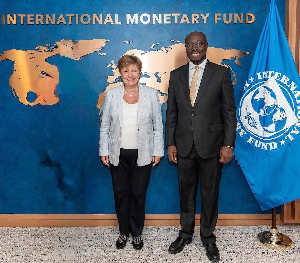The country’s commodity price movements in the first two months of 2021 adversely impacted the trade balance, bringing total exports down by 9.2 per year-on-year to US$2.5 billion.
The drop was driven mainly by a 25.8 percent year-on-year decline in crude oil exports (due to lower volumes), 12.2 percent decline in cocoa beans exports (due to lower volumes and prices), and 5.6 percent decline in gold exports (due to lower volumes).
Total imports, on the other hand, went up by 9.6 percent to US$2.2 billion, underpinned by a 12.9 percent year-on-year increase in non-oil imports due to a pick-up in economic activities.
Consequently, the trade balance recorded a lower surplus of USD339.7 million (0.5 percent of GDP) in the first two months of 2021, compared with US$791 million (1.2 percent of GDP) same period in 2020.
This was contained in a statement issued by the Bank of Ghana Monetary Policy Committee after the 99th meeting.
The Central Bank maintained the policy rate at 14.5 percent for the fifth consecutive time.
It said the Ghanaian economy was on a rebound with a sustained momentum in pick-up in economic activity. The Bank’s updated Composite Index of Economic Activity (CIEA) recorded an annual growth of 13.9 percent in January 2021, the highest since December 2019, compared to 3.4 percent in the corresponding period of 2020. It noted that the key drivers of economic activity during the period were construction, imports, industrial consumption of electricity, domestic VAT, passenger arrivals at the airport, and port activity.
The statement further said the average price of Ghana’s major commodities (cocoa, gold and crude oil) traded mixed in February 2021. “Crude oil prices gained 12.6 percent to settle at an average price of US$62.3 per barrel compared to US$55.3 per barrel in January, supported by lower US crude inventories, rising winter fuel demand, and the massive rollout of vaccine which improved global growth prospects,” it said.
It added that on the contrary, gold prices suffered some losses due to the strengthening of the US dollar and rising US Treasury yields. As a result, gold prices declined by 3.0 percent in February 2021 to US$1,810.3 per ounce compared to US$1,867.0 per ounce in January. Cocoa prices declined marginally to US$2,508.8 per tonne in February 2021 compared to the US$2,523.9 per tonne a month earlier.
A combination of weak demand due to the pandemic and excess supply in Ivory Coast accounted for the price drop.
The statement said interest rates on the money market broadly showed downward trends for short-dated instruments and mixed trends for medium to long-dated instruments. The 91-day and 182-day Treasury bill rates declined to 13.6 percent and 14.0 percent respectively in February 2021, from 14.7 percent and 15.2 percent respectively, in February 2020.
It said similarly, the rate on the 364-day instrument decreased to 16.9 percent from 17.8 percent over the same comparative period. “Rates on the secondary bond market have also generally declined, except for rates on the 5-year bond which increased by 35 bps to 19.9 percent,” it added. The statement noted yields on 2-year, 3-year, 6-year and 7-year bonds declined, while rates on the 10-year, 15-year and 20-year bonds remained unchanged.
Business News of Sunday, 28 March 2021
Source: thefinderonline.com













